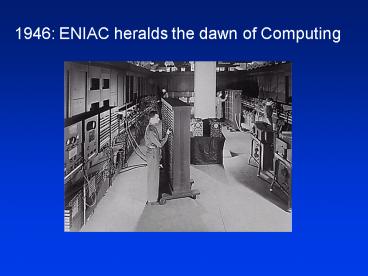Refinement Planning: Status and Prospectus - PowerPoint PPT Presentation
Title:
Refinement Planning: Status and Prospectus
Description:
coast to coast. CMU's RALPH program drove a van for all but 52 miles ... A focus on problems that do not respond to algorithmic solutions. ... – PowerPoint PPT presentation
Number of Views:64
Avg rating:3.0/5.0
Title: Refinement Planning: Status and Prospectus
1
1946 ENIAC heralds the dawn of Computing
2
1950 Turing asks the question.
I propose to consider the question
Can machines think?
--Alan Turing, 1950
3
1995 RALPH takes a trip from coast to coast
CMUs RALPH program drove a van for all but 52
miles of a trip from D.C. to San Diego
4
1996 EQP proves that Robbins Algebras are all
boolean
An Argonne lab program has come up with a major
mathematical proof that would have been called
creative if a human had thought of it.
-New
York Times, December, 1996
5
Jan 12, 1997 HAL 9000 becomes operational in
fictional Urbana, Illinois
by now, every intelligent person knew that
H-A-L is derived from Heuristic ALgorithmic
-Dr. Chandra, 2010 Odyssey Two
6
May, 1997 Deep Blue beats the World Chess
Champion
vs.
I could feel human-level intelligence across the
room -Gary Kasparov, World Chess
Champion (human)
7
May, 1999 Remote Agent takes Deep Space 1 on a
galactic ride
8
May 2000 SCIFINANCEsynthesizes programsfor
financial modeling
- Develop pricing models for complex derivative
structures - Involves the solution of a set of PDEs (partial
differential equations) - Integration of object-oriented design, symbolic
algebra, and plan-based scheduling
9
Sept. 2002 Cindy Smart marketed
- Vision can read, tell the time
- Speech recognition can recognize 700 words and
77 phrases - Voice synthesis speaks with a soft voice
10
What else?
- Real-time response
- robustness
- autonomous intelligent interaction with the
environment - planning
- communication with natural language
- commonsense reasoning
- creativity
- learning
- ???
11
Administrivia
- Textbook Lugers Artificial Intelligence, 2002,
Addison Wesley - Grading
- Assignments 40
- Midterm Exam 1 20
- Midterm Exam 2 20
- Final Exam 20
- Academic honesty
12
Contents
- PART I Artificial Intelligence Its Roots and
Scope - Chapter 1 AI History and Applications
- PART II Artificial Intelligence as
Representation and Search - Chapter 2 The Predicate Calculus
- Chapter 3 Structures and Strategies for State
Space Search - Chapter 4 Heuristic Search
- Chapter 5 Control and Implementation of
State-Space Search
13
Contents (contd)
- Part III Representation and Intelligence The AI
Challenge - Chapter 6 Knowledge Representation
- Chapter 7 Strong Method Problem Solving
- Chapter 8 Reasoning in Uncertain Situations
14
Contents (contd)
- Part IV Machine Learning
- Chapter 9 Machine Learning Symbol-based
- Chapter 10 Machine Learning Connectionist
- Chapter 11 Machine Learning Social and Emergent
15
Contents (contd)
- Part V Advanced Topics for AI Problem Solving
- Chapter 12 Automated Reasoning
- Chapter 13 Understanding Natural Language
16
Contents (contd)
- Part VI Languages and Programming Techniques for
AI - Chapter 14 An Introduction to Prolog
- Chapter 15 An Introduction to Lisp
- Part VII Epilogue
- Chapter 16 Artificial Intelligence as Empirical
Enquiry
17
What is AI?
18
Figure 1.1 The Turing test.
19
Definitions of AI
- Systems that think like humans
- Systems that act like humans
- Systems that think rationally
- Systems that act rationally
20
Question
- What would impress you as an
- intelligent system?
21
Important Research and Application Areas
- Game playing
- Automated Reasoning and Theorem Proving
- Expert Systems
- Natural Language Understanding and Semantic
Modeling - Modeling Human Performance
- Planning and Robotics
- Languages and Environments for AI
- Machine Learning
- Alternative Representations Neural Nets and
Genetic Algorithms - AI and Philosophy
22
Important Features of AI
- The use of computers to do reasoning, pattern
recognition, learning, or some other form of
inference. - A focus on problems that do not respond to
algorithmic solutions. This underlies the
reliance on heuristic search as an AI
problem-solving technique. - A concern with problem solving using inexact,
missing, or poorly defined information and the
use of representational formalisms that enable
the programmer to compensate for these problems.
23
Important Features of AI (contd)
- Reasoning about the significant qualitative
features of a situation. - An attempt to deal with issues of semantic
meaning as well as syntactic form. - Answers that are neither exact nor optimal, but
are in some sense sufficient. This is a result
of the essential reliance on heuristic
problem-solving methods in situations where
optimal or exact results are either too expensive
or not possible.
24
Important Features of AI (contd)
- The use of large amounts of domain-specific
knowledge in solving problems. This is the basis
of expert systems. - The use of meta-level knowledge to effect more
sophisticated control of problem solving
strategies. Although this is a very difficult
problem, addressed in relatively few current
systems, it is emerging as an essential area of
research.































